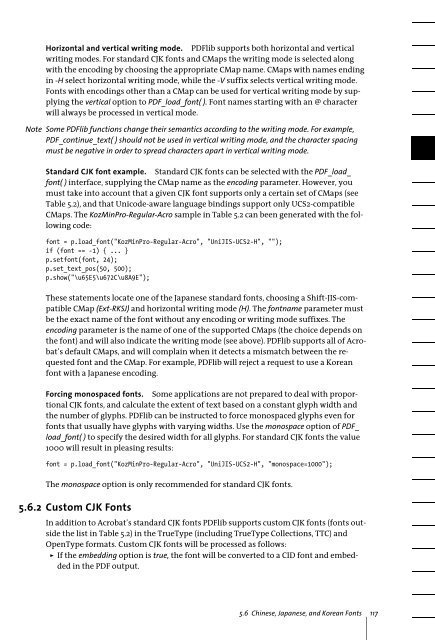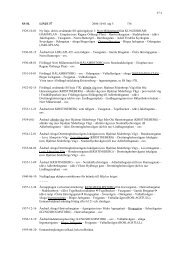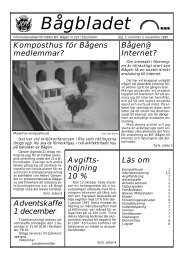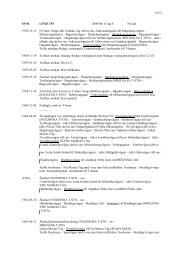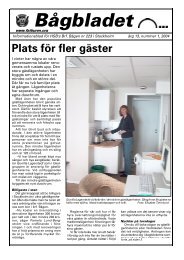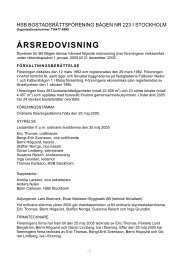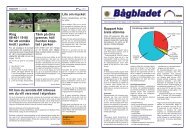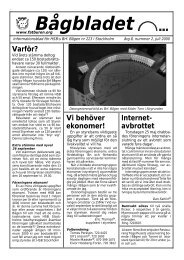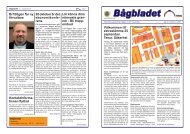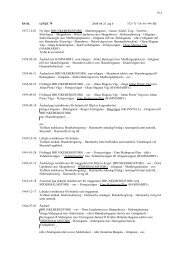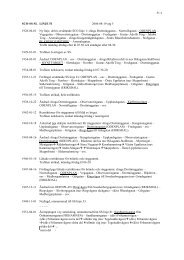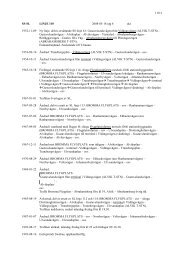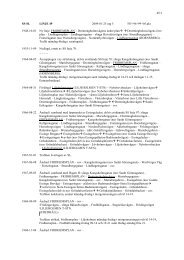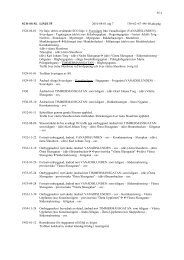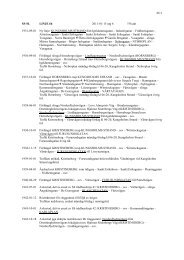5.6 Chinese, Japanese, and Korean Fonts5.6.1 Standard CJK FontsAcrobat supports various standard fonts for CJK text. These fonts are supplied with theAcrobat installation (or the Asian FontPack), and therefore don’t have to be embeddedin the PDF file. These fonts contain all characters required for common encodings, andsupport both horizontal and vertical writing modes. The standard fonts are listed in Table5.2 along with applicable CMaps (see Section 4.5, »Encodings for Chinese, Japanese,and Korean Text«, page 85, for more details on CJK CMaps).Note Acrobat’s standard CJK fonts do not support bold and italic variations. However, these can besimulated with the artificial font style feature (see Section 5.5.3, »Text Variations«, page 114).Table 5.2 Acrobat’s standard fonts and CMaps (encodings) for Japanese, Chinese, and Korean textlocale font name sample supported CMaps (encodings)SimplifiedChineseTraditionalChineseSTSong-Light 1STSongStd-Light-Acro 2AdobeSongStd-Light-Acro 3AdobeSongStd-Light 6MHei-Medium 1MSung-Light 1MSungStd-Light-Acro 2AdobeMingStd-Light-Acro 3AdobeMingStd-Light 6Japanese HeiseiKakuGo-W5 1HeiseiMin-W3 1KozMinPro-Regular-Acro 2, 7KozGoPro-Medium-Acro 3, 7KozGoPro-Medium 6KozMinProVI-Regular 6Korean HYGoThic-Medium 1HYSMyeongJo-Medium 1HYSMyeongJoStd-Medium-Acro 2AdobeMyungjoStd-Medium-Acro 3AdobeMyungjoStd-Medium 6GB-EUC-H, GB-EUC-V, GBpc-EUC-H, GBpc-EUC-V,GBK-EUC-H, GBK-EUC-V, GBKp-EUC-H 4 , GBKp-EUC-V 2 , GBK2K-H 2 , GBK2K-V 2 , UniGB-UCS2-H, UniGB-UCS2-V, UniGB-UTF16-H 5 , UniGB-UTF16-V 5B5pc-H, B5pc-V, HKscs-B5-H 4 , HKscs-B5-V 4 , ETen-B5-H, ETen-B5-V, ETenms-B5-H, ETenms-B5-V, CNS-EUC-H, CNS-EUC-V, UniCNS-UCS2-H, UniCNS-UCS2-V, UniCNS-UTF16-H 5 , UniCNS-UTF16-V 583pv-RKSJ-H, 90ms-RKSJ-H, 90ms-RKSJ-V, 90msp-RKSJ-H, 90msp-RKSJ-V, 90pv-RKSJ-H, Add-RKSJ-H,Add-RKSJ-V, EUC-H, EUC-V, Ext-RKSJ-H, Ext-RKSJ-V,H, V, UniJIS-UCS2-H, UniJIS-UCS2-V, UniJIS-UCS2-HW-H 7 , UniJIS-UCS2-HW-V 7 , UniJIS-UTF16-H 5 , UniJIS-UTF16-V5KSC-EUC-H, KSC-EUC-V, KSCms-UHC-H, KSCms-UHC-V, KSCms-UHC-HW-H, KSCms-UHC-HW-V,KSCpc-EUC-H, UniKS-UCS2-H, UniKS-UCS2-V, UniKS-UTF16-H5 , UniKS-UTF16-V 51. Available in Acrobat 4; Acrobat 5 and 6 will substitute these with different fonts.2. Available in Acrobat 5 only3. Available in Acrobat 6 only4. Only available when generating PDF 1.4 or above5. Only available when generating PDF 1.5 or above6. Only available when generating PDF 1.6 or above7. The HW CMaps are not allowed for the KozMinPro-Regular-Acro and KozGoPro-Medium-Acro fonts because these fonts contain onlyproportional ASCII characters, but not any halfwidth forms.116 Chapter 5: Font Handling
Horizontal and vertical writing mode. PDFlib supports both horizontal and verticalwriting modes. For standard CJK fonts and CMaps the writing mode is selected alongwith the encoding by choosing the appropriate CMap name. CMaps with names endingin -H select horizontal writing mode, while the -V suffix selects vertical writing mode.Fonts with encodings other than a CMap can be used for vertical writing mode by supplyingthe vertical option to PDF_load_font( ). Font names starting with an @ characterwill always be processed in vertical mode.Note Some PDFlib functions change their semantics according to the writing mode. For example,PDF_continue_text( ) should not be used in vertical writing mode, and the character spacingmust be negative in order to spread characters apart in vertical writing mode.Standard CJK font example. Standard CJK fonts can be selected with the PDF_load_font( ) interface, supplying the CMap name as the encoding parameter. However, youmust take into account that a given CJK font supports only a certain set of CMaps (seeTable 5.2), and that Unicode-aware language bindings support only UCS2-compatibleCMaps. The KozMinPro-Regular-Acro sample in Table 5.2 can been generated with the followingcode:font = p.load_font("KozMinPro-Regular-Acro", "UniJIS-UCS2-H", "");if (font == -1) { ... }p.setfont(font, 24);p.set_text_pos(50, 500);p.show("\u65E5\u672C\u8A9E");These statements locate one of the Japanese standard fonts, choosing a Shift-JIS-compatibleCMap (Ext-RKSJ) and horizontal writing mode (H). The fontname parameter mustbe the exact name of the font without any encoding or writing mode suffixes. Theencoding parameter is the name of one of the supported CMaps (the choice depends onthe font) and will also indicate the writing mode (see above). PDFlib supports all of Acrobat’sdefault CMaps, and will complain when it detects a mismatch between the requestedfont and the CMap. For example, PDFlib will reject a request to use a Koreanfont with a Japanese encoding.Forcing monospaced fonts. Some applications are not prepared to deal with proportionalCJK fonts, and calculate the extent of text based on a constant glyph width andthe number of glyphs. PDFlib can be instructed to force monospaced glyphs even forfonts that usually have glyphs with varying widths. Use the monospace option of PDF_load_font( ) to specify the desired width for all glyphs. For standard CJK fonts the value1000 will result in pleasing results:font = p.load_font("KozMinPro-Regular-Acro", "UniJIS-UCS2-H", "monospace=1000");The monospace option is only recommended for standard CJK fonts.5.6.2 Custom CJK FontsIn addition to Acrobat’s standard CJK fonts PDFlib supports custom CJK fonts (fonts outsidethe list in Table 5.2) in the TrueType (including TrueType Collections, TTC) andOpenType formats. Custom CJK fonts will be processed as follows:> If the embedding option is true, the font will be converted to a CID font and embeddedin the PDF output.5.6 Chinese, Japanese, and Korean Fonts 117
- Page 1 and 2:
PDFlib GmbH München, Germanywww.pd
- Page 3 and 4:
Contents0 Applying the PDFlib Licen
- Page 5 and 6:
5.6.1 Standard CJK Fonts 1165.6.2 C
- Page 7 and 8:
10.2.2 Block Properties 22710.2.3 W
- Page 9:
0 Applying the PDFlib License KeyAl
- Page 12 and 13:
Licensing options. Different licens
- Page 14 and 15:
PDFlib TET (Text Extraction Toolkit
- Page 16 and 17:
PDFlib can be integrated directly i
- Page 18 and 19:
Improved handling of Chinese, Japan
- Page 20 and 21:
1.4 Features in PDFlib/PDFlib+PDI/P
- Page 22 and 23:
1.5 Availability of Features in dif
- Page 24 and 25:
24 Chapter 1: Introduction
- Page 26 and 27:
2.2 COM Binding(This section is onl
- Page 28 and 29:
necessary. After fatal exceptions t
- Page 30 and 31:
2.4 C++ BindingIn addition to the p
- Page 32 and 33:
PDFlib servlets and Java applicatio
- Page 34 and 35:
2.6 .NET Binding(This section is on
- Page 36 and 37:
More than one way of String handlin
- Page 38 and 39:
PHP on Windows will find files with
- Page 40 and 41:
2.10 REALbasic Binding 1(This secti
- Page 42 and 43:
Now you can compile your program us
- Page 44 and 45:
2.13 Tcl BindingInstalling the PDFl
- Page 46 and 47:
Error policies. When PDFlib detects
- Page 48 and 49:
plied), but only the corresponding
- Page 50 and 51:
name exactly as supplied and try to
- Page 52 and 53:
3.1.4 Generating PDF Documents in M
- Page 54 and 55:
3.2 Page Descriptions3.2.1 Coordina
- Page 56 and 57:
In order to facilitate the use of t
- Page 58 and 59:
Merely constructing a path doesn’
- Page 60 and 61:
3.3 Working with ColorNote The PDFl
- Page 62 and 63:
where is the identifier of the col
- Page 64 and 65:
Rendering Intents. Although PDFlib
- Page 66 and 67: p.set_parameter("errorpolicy", "ret
- Page 68 and 69: with a thin black border. Initially
- Page 70 and 71: }p.begin_page_ext(pagewidth, pagehe
- Page 72 and 73: Table 3.5 Parameters for the JavaSc
- Page 74 and 75: 4.2 Important Unicode ConceptsChara
- Page 76 and 77: 4.3 Strings in PDFlib4.3.1 String T
- Page 78 and 79: EBCDIC UTF-8 BOM). If the usehypert
- Page 80 and 81: values 0x7B and 0x7D must be preced
- Page 82 and 83: Table 4.4 Availability of glyphs fo
- Page 84 and 85: exclam 33 0x0021...If no Unicode va
- Page 86 and 87: Table 4.5 Predefined CMaps for Japa
- Page 88 and 89: 4.6 Addressing Characters and Glyph
- Page 90 and 91: Table 4.8 Control characters and th
- Page 92 and 93: glyphcheck=replace: silent approach
- Page 94 and 95: 94 Chapter 4: Unicode and Legacy En
- Page 96 and 97: 5.1.2 Font EncodingsAll fonts for t
- Page 98 and 99: 5.2 Font Format Details5.2.1 PostSc
- Page 100 and 101: the contents of the characters in a
- Page 102 and 103: Path resource category (again, the
- Page 104 and 105: When working with host fonts it is
- Page 106 and 107: Note The Leopard builds of PDFlib (
- Page 108 and 109: put by default. For encodings which
- Page 110 and 111: 5.4.2 Glyph ID Addressing for TrueT
- Page 112 and 113: 5.5 Font Metrics and Text Variation
- Page 114 and 115: Temporarily disabling kerning may b
- Page 118 and 119: CJK host font names on Windows can
- Page 120 and 121: 120 Chapter 5: Font Handling
- Page 122 and 123: tion) if the user coordinate system
- Page 124 and 125: color: black and white, grayscale,
- Page 126 and 127: PDFlib supports three kinds of tran
- Page 128 and 129: BMP> PNG> JPEG> TIFF> GIFFor images
- Page 130 and 131: 6.2 Importing PDF Pages with PDI (P
- Page 132 and 133: Alternatively, you can use the pdiu
- Page 134 and 135: 20Kraxitext on top right of the box
- Page 136 and 137: can be used. In Figure 7.5h the tex
- Page 138 and 139: 7.1.5 Placing a StampCookbook A ful
- Page 140 and 141: 7.2 Multi-Line TextflowsIn addition
- Page 142 and 143: piece of normal text. Font, font si
- Page 144 and 145: leftindent = 15parindent = 20leadin
- Page 146 and 147: hortabmethod rulertabalignment left
- Page 148 and 149: leftindent = &indentparindent = - &
- Page 150 and 151: To fold the famous rocket looper pr
- Page 152 and 153: Our paper planes are the ideal way
- Page 154 and 155: Our paper planesare the ideal way o
- Page 156 and 157: p.fit_textflow(textflow, left_x, le
- Page 158 and 159: 7.3 Placing Images and Imported PDF
- Page 160 and 161: Fig. 7.28 Fitting an image into a b
- Page 162 and 163: Fitting an oriented image into a bo
- Page 164 and 165: 7.4 Table FormattingThe table forma
- Page 166 and 167:
tbl = p.add_table_cell(tbl, 1, 1, "
- Page 168 and 169:
cell border as the Material text. T
- Page 170 and 171:
those width values will implicitly
- Page 172 and 173:
column defining a column width of 1
- Page 174 and 175:
The table in Figure 7.42 is spread
- Page 176 and 177:
Splitting a row. If the last body d
- Page 178 and 179:
To increase the box height to match
- Page 180 and 181:
Fig. 7.48 Using the image matchbox
- Page 182 and 183:
size of a page. Determining the pag
- Page 184 and 185:
8.3 Composite Data Structures and I
- Page 186 and 187:
Table 8.2 pCOS path prefixesprefixl
- Page 188 and 189:
Table 8.3 Universal pseudo objectso
- Page 190 and 191:
Table 8.4 Pseudo objects for PDF ob
- Page 192 and 193:
Table 8.5 Pseudo objects for resour
- Page 194 and 195:
194 Chapter 8: The pCOS Interface
- Page 196 and 197:
Table 9.2 PDFlib features for PDF 1
- Page 198 and 199:
to disable any access restrictions.
- Page 200 and 201:
Table 9.4 Access restriction keywor
- Page 202 and 203:
9.4 PDF/X for Print Production9.4.1
- Page 204 and 205:
Table 9.6 Operations which must be
- Page 206 and 207:
work as a full PDF/X validator or t
- Page 208 and 209:
9.5.2 Generating PDF/A-conforming O
- Page 210 and 211:
Table 9.11 Additional requirements
- Page 212 and 213:
This statement will retrieve a stri
- Page 214 and 215:
Table 9.16 Predefined XMP schemas f
- Page 216 and 217:
9.6 Tagged PDFTagged PDF is a certa
- Page 218 and 219:
quired, but will enhance the qualit
- Page 220 and 221:
* 1 create top part of left column
- Page 222 and 223:
optlist = "Title=Insert parent=" +
- Page 224 and 225:
exported to other formats. If the A
- Page 226 and 227:
Click Add... and select the PDFlib
- Page 228 and 229:
scaling factor or rotation. For eac
- Page 230 and 231:
10.3 Using the PDFlib Block Plugin
- Page 232 and 233:
next step other objects which are p
- Page 234 and 235:
Use Ctrl-V (on Windows) or Cmd-V (o
- Page 236 and 237:
Associating form fields with corres
- Page 238 and 239:
Property overrides can be achieved
- Page 240 and 241:
10.5 Standard Properties for Automa
- Page 242 and 243:
10.5.2 Text PropertiesText-related
- Page 244 and 245:
Table 10.6 Textflow block propertie
- Page 246 and 247:
Table 10.6 Textflow block propertie
- Page 248 and 249:
10.6 Querying Block Names and Prope
- Page 250 and 251:
10.7 PDFlib Block SpecificationThe
- Page 252 and 253:
Example. The following fragment sho
- Page 254 and 255:
254 Chapter 10: Variable Data and B
- Page 256 and 257:
256
- Page 258 and 259:
Ffeatures of PDFlib 20fill 57font m
- Page 260:
TrimBox 57TrueType fonts 95TTC (Tru


